German actor Carl de Vogt (1885-1970) was a forerunner of Indiana Jones in the silent adventure films of Fritz Lang. He appeared in more than 100 films. De Vogt was also a popular singer and made several records in the 1920s.

German photocard for the album Vom Werden deutscher Filmkunst. Teil I. Der stumme Film (Cigaretten-Bilderdienst Altona-Bahrenfeld 1935) by Ross Verlag. Photo: Decla-Film. Lil Dagover and Carl de Vogt in Die Spinnen/The Spiders (1919-1920).

German postcard by Verlag Hermann Leiser, Berlin, no. 3143. Publicity still of Carl de Vogt in Ahasver (Robert Reinert, 1917). Ahasver is a three-part film on the story of the Wandering Jew Ahasver (De Vogt), who is condemned to bring misfortune.

German postcard by Verlag Hermann Leiser, Berlin, no. 3146. Photo: Carl de Vogt and Johannes Riemann in Ahasver (Robert Reinert, 1917).
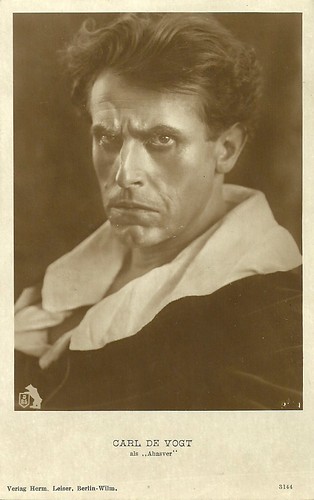
German postcard by Verlag Hermann Leiser, Berlin, no. 3144. Photo: Deutsche Bioscop-Gesellschaft (DBG). Carl de Vogt in Ahasver (Robert Reinert, 1917).
Carl de Vogt was born in Köln (Cologne), Germany, in 1885.
He attended the acting school in his hometown, and then started his career as a stage actor. His earliest known film was Schwert und Herd (1916).
In the following years De Vogt became a popular star, in particular in adventure films.
Well-known are his contributions to four early films of Fritz Lang in which he was a kind of Indiana Jones avant la lettre: Halbblut/The Half-Caste (1919), Der Herr der Liebe/Master of Love (1919) and the two-part Die Spinnen/The Spiders (1919-1920), opposite Lil Dagover and Ressel Orla.
In the Karl May adaptation Die Teufelsanbeter/The Devil Worshippers (Marie Luise Droop, 1920) he appeared as Kara Ben Nemsi opposite Béla Lugosi. He married film actress Claire Lotto with whom he played together several times.
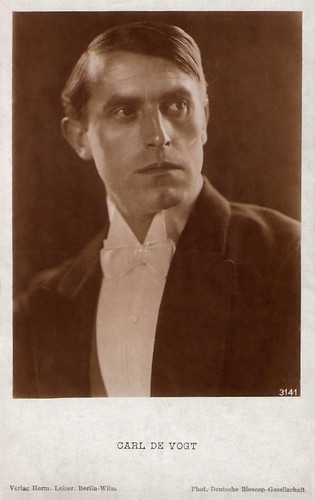
German postcard by Verlag Hermann Leiser, Berlin-Wilm., no. 3141. Photo: Deutsche Bioscop-Gesellschaft.
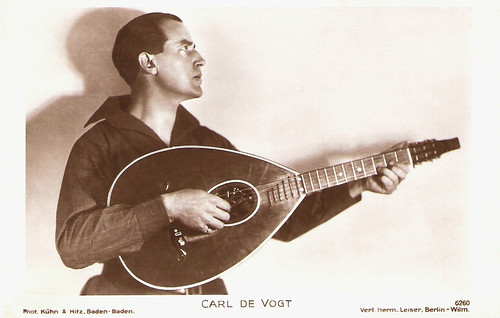
German postcard by Verlag Hermann Leiser, Berlin-Wilm., no. 6260. Photo: Kühn & Hitz, Baden-Baden.
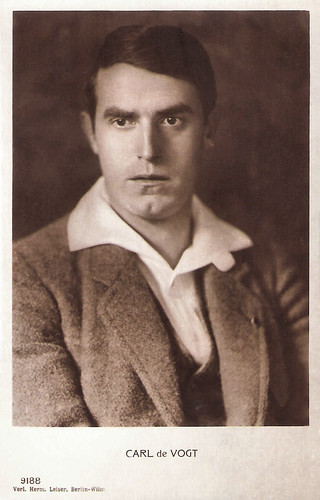
German postcard by Verlag Hermann Leiser, Berlin-Wilm., no. 9188.
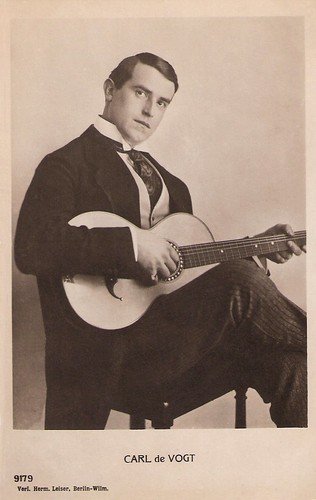
German postcard by Verlag Hermann Leiser, Berlin-Wilmersdorf, no. 9179.
In the early 1920s, Carl de Vogt became an even bigger star, because of his successful performances in such films as Die Todeskarawane/Caravan of Death (Josef Stein, 1920) - again as Kara Ben Nemsi, the two-part Die Schatzkammer im See/The Treasure Room in the Sea (Hans Werckmeister, 1921), Der Herr der Bestien/The Master of the Beasts (Ernst Wendt, 1921), Die Tigerin/The Tigress (Ernst Wendt, 1922), and as Hektor in Helena/Helen of Troy (Manfred Noa, 1924).
Next to acting he was also a popular singer and he made several records in the 1920s. His biggest hit was Der Fremdenlegionär (The Foreign Legionnaire).
From the 1930s to the 1950s he continued to play in dozens of films, but his real glory days were over and his parts got smaller and smaller.
His last film was the Bryce Edgar Wallace krimi Der Würger von Schloß Blackmoor/The Strangler of Blackmoor Castle (Harald Reinl, 1963). Carl de Vogt died in Berlin in 1970. He had a son with Claire Lotto, Karl Franz de Vogt (1917).

Austrian postcard by Iris Verlag, no. 650. Photo: Residenz-Atelier, Wien (Vienna).

German postcard by Ross Verlag, no. 266/4, 1919-1924. Photo: Alex Binder.
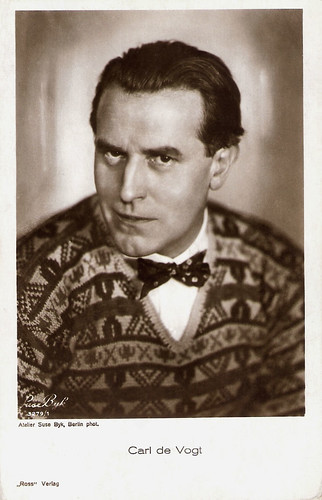
German postcard by Ross Verlag, no. 3279/1, 1928-1929. Photo: Suse Byk, Berlin.
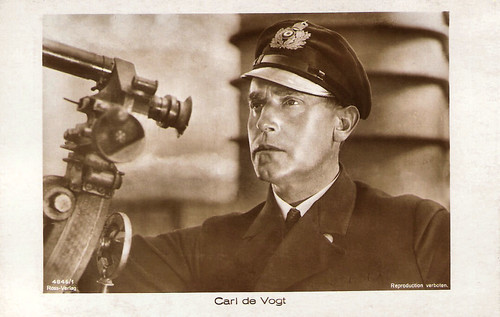
German postcard by Ross Verlag, no. 4846/1, 1929-1930.
Sources: Thomas Staedeli (Cyranos), Wikipedia, and IMDb.

German photocard for the album Vom Werden deutscher Filmkunst. Teil I. Der stumme Film (Cigaretten-Bilderdienst Altona-Bahrenfeld 1935) by Ross Verlag. Photo: Decla-Film. Lil Dagover and Carl de Vogt in Die Spinnen/The Spiders (1919-1920).

German postcard by Verlag Hermann Leiser, Berlin, no. 3143. Publicity still of Carl de Vogt in Ahasver (Robert Reinert, 1917). Ahasver is a three-part film on the story of the Wandering Jew Ahasver (De Vogt), who is condemned to bring misfortune.

German postcard by Verlag Hermann Leiser, Berlin, no. 3146. Photo: Carl de Vogt and Johannes Riemann in Ahasver (Robert Reinert, 1917).

German postcard by Verlag Hermann Leiser, Berlin, no. 3144. Photo: Deutsche Bioscop-Gesellschaft (DBG). Carl de Vogt in Ahasver (Robert Reinert, 1917).
Kara Ben Nemsi
Carl de Vogt was born in Köln (Cologne), Germany, in 1885.
He attended the acting school in his hometown, and then started his career as a stage actor. His earliest known film was Schwert und Herd (1916).
In the following years De Vogt became a popular star, in particular in adventure films.
Well-known are his contributions to four early films of Fritz Lang in which he was a kind of Indiana Jones avant la lettre: Halbblut/The Half-Caste (1919), Der Herr der Liebe/Master of Love (1919) and the two-part Die Spinnen/The Spiders (1919-1920), opposite Lil Dagover and Ressel Orla.
In the Karl May adaptation Die Teufelsanbeter/The Devil Worshippers (Marie Luise Droop, 1920) he appeared as Kara Ben Nemsi opposite Béla Lugosi. He married film actress Claire Lotto with whom he played together several times.

German postcard by Verlag Hermann Leiser, Berlin-Wilm., no. 3141. Photo: Deutsche Bioscop-Gesellschaft.

German postcard by Verlag Hermann Leiser, Berlin-Wilm., no. 6260. Photo: Kühn & Hitz, Baden-Baden.

German postcard by Verlag Hermann Leiser, Berlin-Wilm., no. 9188.

German postcard by Verlag Hermann Leiser, Berlin-Wilmersdorf, no. 9179.
Popular Singer
In the early 1920s, Carl de Vogt became an even bigger star, because of his successful performances in such films as Die Todeskarawane/Caravan of Death (Josef Stein, 1920) - again as Kara Ben Nemsi, the two-part Die Schatzkammer im See/The Treasure Room in the Sea (Hans Werckmeister, 1921), Der Herr der Bestien/The Master of the Beasts (Ernst Wendt, 1921), Die Tigerin/The Tigress (Ernst Wendt, 1922), and as Hektor in Helena/Helen of Troy (Manfred Noa, 1924).
Next to acting he was also a popular singer and he made several records in the 1920s. His biggest hit was Der Fremdenlegionär (The Foreign Legionnaire).
From the 1930s to the 1950s he continued to play in dozens of films, but his real glory days were over and his parts got smaller and smaller.
His last film was the Bryce Edgar Wallace krimi Der Würger von Schloß Blackmoor/The Strangler of Blackmoor Castle (Harald Reinl, 1963). Carl de Vogt died in Berlin in 1970. He had a son with Claire Lotto, Karl Franz de Vogt (1917).

Austrian postcard by Iris Verlag, no. 650. Photo: Residenz-Atelier, Wien (Vienna).

German postcard by Ross Verlag, no. 266/4, 1919-1924. Photo: Alex Binder.

German postcard by Ross Verlag, no. 3279/1, 1928-1929. Photo: Suse Byk, Berlin.

German postcard by Ross Verlag, no. 4846/1, 1929-1930.
Sources: Thomas Staedeli (Cyranos), Wikipedia, and IMDb.
No comments:
Post a Comment